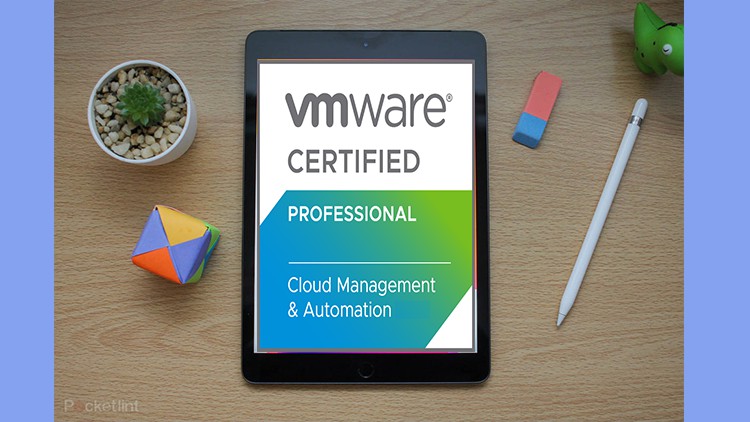
What you will learn
Practice Tests for VMware Cloud Management and Automation Certification
Practice tips for VMware Cloud Management and Automation Certification
Practice same Exam for VMware Cloud Management and Automation Certification
Discover all tricks in exam certification
Description
Purpose of Exam
The VMware Certified Professional – Cloud Management and Automation Exam (2V0-731) tests candidates on their skills and abilities installing, configuring and administering a VMware vRealize® environment.
Exam Sections
VMware exam blueprint sections are now standardized to the seven sections below, some of which may NOT be included in the final exam blueprint depending on the exam objectives.
Section 1 – Architecture and Technologies
Section 2 – Products and Solutions
Section 3 – Planning and Designing
Section 4 – Installing, Configuring, and Setup
Section 5 – Performance-tuning, Optimization, and Upgrades
Section 6 – Troubleshooting and Repairing
Section 7 – Administrative and Operational Tasks
If a section does not have testable objectives in this version of the exam, it will be noted below, accordingly. The objective numbering may be referenced in your score report at the end of your testing event for further preparation should a retake of the exam be necessary.
Sections Included in this Exam
Section 1 – Architecture and Technologies
Objective 1.1 – Differentiate between architecting a solution on SaaS vs on-prem (i.e. cloud proxy)
Objective 1.2 – Differentiate between business and technical requirements
Objective 1.3 – Differentiate conceptual, logical and detailed design
Objective 1.4 – Differentiate between Availability, Manageability, Performance, Recoverability and Security (AMPRS)
Section 2 – Products and Solutions
Objective 2.1 – Understand the design principles of VVD
Objective 2.2 – Understand the design of vRealize Cloud Management solutions
Objective 2.3 – Understand the design of VMware Cloud Foundation
Section 3 – Planning and Designing
Objective 3.1 – Gather/Analyze requirements- Business/Technical
Objective 3.2 – Determine risks, constraints, and assumptions for a design
Objective 3.3 – Create a Conceptual Design
Objective 3.4 – Create a vRealize Suite Lifecycle Manager Logical Design
Objective 3.5 – Create a VMware Identity Manager Logical Design
Objective 3.6 – Create a vRealize Automation Logical Design
Objective 3.7 – Create a vRealize Operations Logical Design
3.7.1 Determine the architecture of a vROps environment based on requirements
Objective 3.8 – Create vRealize Log Insight Logical design
Objective 3.9 – Create a vRealize Cloud Automation Extensibility Design (Orchestrator/ABX)
Objective 3.10– Create a VMware Vrealize Sutie Lifecycle Manager Physical Design
Objective 3.11 – Create a VMware Identity Manager Physical Design
Objective 3.12 – Create a vRealize Automation Physical Design
3.12.1 Determine the appropriate tenancy model based on requirements
3.12.2 Determine the appropriate RBAC design based on requirements
Objective 3.13 – Create a vRealize Operations Physical Design
3.13.1 Determine the appropriate RBAC design based on requirements
3.13.2 Determine the appropriate Operational & Business Intent configuration based on requirements
3.13.3 Determine the size of a vROps Cluster based on requirements
3.13.4 Determine the architecture of a vROps environment based on requirements
3.13.5 Best Practices for vROps
Objective 3.14 – Create vRealize Log Insight Physical Design
3.14.1 Determine the appropriate RBAC design based on requirements
3.14.2 Determine the size of a vRLI Cluster based on requirements
3.14.3 Determine the architecture of a vRLI environment based on requirements
Objective 3.15 – Create a vRealize Automation Tenant Design (Cloud Assembly)
3.15.1 Determine the appropriate Cloud Account configuration based on requirements
3.15.2 Determine the appropriate Integration configuration based on requirements
3.15.3 Determine the appropriate Project design/confiugration based on requirements
3.15.4 Determine the appropriate Image Mapping design based on requirements
3.15.5 Determine the appropriate Flavor Mapping design based on requirements
3.15.6 Determine the appropriate Storage Profile design based on requirements
3.15.7 Determine the appropriate Network Profile design based on requirements
Objective 3.16 – Create a vRealize Automation Service Catalog Design (Service Broker)
3.16.1 Determine the appropriate Content based on requirements
Objective 3.17 – Determine the vRealize Suite Integrations based on requirements
3.17.1 vROps – vRA integration (Workload Placement, Health and Pricing)
3.17.2 vROps – vRLI Integrations (Alerts)
Section 4 – There are no testable objectives for this section.
Section 5 – There are no testable objectives for this section.
Section 6 – There are no testable objectives for this section.